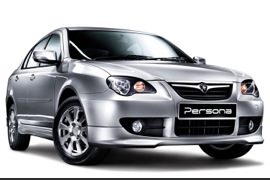PROTON Persona Models/Series Timeline, Specifications & Photos
First production year: 2007
Engines: Gasoline
While the older Proton models were licensed Mitsubishi products, the 2016 Persona took a different path, and the Malaysian carmaker built a new generation on a new platform.
Proton worked hard to get a vehicle designed by their engineering team. The designers might not have been as inspired as the rest of the team, but they did a good job. Worth mentioned that Proton owned the British Lotus car company, and they worked together on the powertrain and suspension.
With a look that resembled some Kia models, but in a smaller package than the previous Persona generation, the 2016 model followed a new-edge design language. Its angular headlights, big grille from the lower side of the bumper, and side-scoops where the fog-lights were hosted enhanced the look of the car. The sculptured door panels, with ascending lines followed on the rear quarter panels, made the vehicle look more dynamic from the sides. But it is hard not to notice the tall, almost flat, side area. In the back, the black lower side of the bumper improved the not-so-handsome rear end.
Inside, the Persona was a surprise, offering decent legroom and headroom. It was bigger inside even its predecessor, which was a larger vehicle. The dashboard looked better in the two-tone color scheme, but the dials for the standard climate controls resembled those found in a Mitsubishi Colt. For the audio system, Proton fitted a CD-stereo as standard for most trim levels. An infotainment unit with sat-nav, 4G connectivity, Android Auto, and Apple CarPlay was on the options list.
Under the hood, Proton installed a 1.6-liter engine with variable valve timing. It was paired to a 5-speed manual or an optional CVT gearbox.
The Malaysian brand Proton replaced the aging Wira model in its home market with the Persona in 2007 and reshaped the company's future.
With the second generation of the Persona, Proton introduced the nameplate on its home market, which previously used the Wira name for the car. But, unlike its predecessor, the new model was no longer a badge-engineered Mitsubishi Lancer. Moreover, its longer wheelbase solved the problem of the rear passengers' legroom.
Proton hired Azlan Othman on the design team, and he shaped the Persona in a new-edge design style. Thus, the car's front got a pair of headlights bigger on the outer side, flanking a new, bolder grille. Moreover, the apron got a more aggressive stance thanks to the lower grille and the side scoops that hosted the foglamps. At the back, the carmaker chose a more affordable solution for the taillights, which were mounted exclusively on the quarter panels flanking the trunk's lid. Depending on the trim level, the Persona also received a set of light-alloy wheels, while the base version got a set of steelie wheels.
Inside, the carmaker offered the Persona with an option for cloth or part-leather upholstery. Even though the dashboard and the door cards were made from budget materials, they revealed Proton's struggle to keep up with the market's demands. Moreover, on the center stack, a Blaupunkt stereo showed the carmaker's concern for its customers. Last but not least, the car was available with modern amenities such as cruise control, and on the safety side, it offered a dual-airbag.
Under the hood, Proton installed a 1.6-liter gasoline engine. As an option, the carmaker offered an LPG version.

